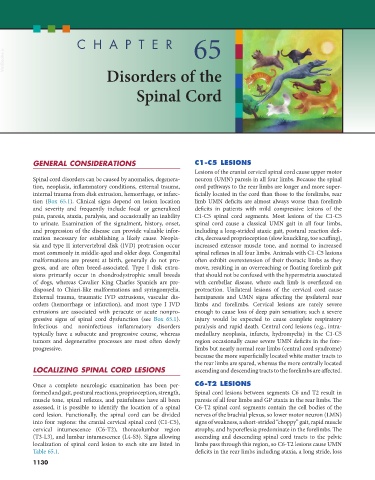Page 1158 - Small Animal Internal Medicine, 6th Edition
P. 1158
1130 PART IX Nervous System and Neuromuscular Disorders
CHAPTER 65
VetBooks.ir
Disorders of the
Spinal Cord
GENERAL CONSIDERATIONS C1-C5 LESIONS
Lesions of the cranial cervical spinal cord cause upper motor
Spinal cord disorders can be caused by anomalies, degenera- neuron (UMN) paresis in all four limbs. Because the spinal
tion, neoplasia, inflammatory conditions, external trauma, cord pathways to the rear limbs are longer and more super-
internal trauma from disk extrusion, hemorrhage, or infarc- ficially located in the cord than those to the forelimbs, rear
tion (Box 65.1). Clinical signs depend on lesion location limb UMN deficits are almost always worse than forelimb
and severity and frequently include focal or generalized deficits in patients with mild compressive lesions of the
pain, paresis, ataxia, paralysis, and occasionally an inability C1-C5 spinal cord segments. Most lesions of the C1-C5
to urinate. Examination of the signalment, history, onset, spinal cord cause a classical UMN gait in all four limbs,
and progression of the disease can provide valuable infor- including a long-strided ataxic gait, postural reaction defi-
mation necessary for establishing a likely cause. Neopla- cits, decreased proprioception (slow knuckling, toe scuffing),
sia and type II intervertebral disk (IVD) protrusion occur increased extensor muscle tone, and normal to increased
most commonly in middle-aged and older dogs. Congenital spinal reflexes in all four limbs. Animals with C1-C5 lesions
malformations are present at birth, generally do not pro- often exhibit overextension of their thoracic limbs as they
gress, and are often breed-associated. Type I disk extru- move, resulting in an overreaching or floating forelimb gait
sions primarily occur in chondrodystrophic small breeds that should not be confused with the hypermetria associated
of dogs, whereas Cavalier King Charles Spaniels are pre- with cerebellar disease, where each limb is overflexed on
disposed to Chiari-like malformations and syringomyelia. protraction. Unilateral lesions of the cervical cord cause
External trauma, traumatic IVD extrusions, vascular dis- hemiparesis and UMN signs affecting the ipsilateral rear
orders (hemorrhage or infarction), and most type I IVD limbs and forelimbs. Cervical lesions are rarely severe
extrusions are associated with peracute or acute nonpro- enough to cause loss of deep pain sensation; such a severe
gressive signs of spinal cord dysfunction (see Box 65.1). injury would be expected to cause complete respiratory
Infectious and noninfectious inflammatory disorders paralysis and rapid death. Central cord lesions (e.g., intra-
typically have a subacute and progressive course, whereas medullary neoplasia, infarcts, hydromyelia) in the C1-C5
tumors and degenerative processes are most often slowly region occasionally cause severe UMN deficits in the fore-
progressive. limbs but nearly normal rear limbs (central cord syndrome)
because the more superficially located white matter tracts to
the rear limbs are spared, whereas the more centrally located
LOCALIZING SPINAL CORD LESIONS ascending and descending tracts to the forelimbs are affected.
Once a complete neurologic examination has been per- C6-T2 LESIONS
formed and gait, postural reactions, proprioception, strength, Spinal cord lesions between segments C6 and T2 result in
muscle tone, spinal reflexes, and painfulness have all been paresis of all four limbs and GP ataxia in the rear limbs. The
assessed, it is possible to identify the location of a spinal C6-T2 spinal cord segments contain the cell bodies of the
cord lesion. Functionally, the spinal cord can be divided nerves of the brachial plexus, so lower motor neuron (LMN)
into four regions: the cranial cervical spinal cord (C1-C5), signs of weakness, a short-strided “choppy” gait, rapid muscle
cervical intumescence (C6-T2), thoracolumbar region atrophy, and hyporeflexia predominate in the forelimbs. The
(T3-L3), and lumbar intumescence (L4-S3). Signs allowing ascending and descending spinal cord tracts to the pelvic
localization of spinal cord lesion to each site are listed in limbs pass through this region, so C6-T2 lesions cause UMN
Table 65.1. deficits in the rear limbs including ataxia, a long stride, loss
1130

